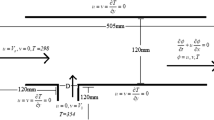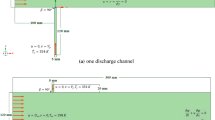Abstract
The problem of two-dimensional mathematical modelling of heated cooling water discharges into running waters is considered in the paper. Two models — one for the evaluation of 2D turbulent velocity field and the other, developed by authors of the study, for 2D heat transport in open-channels — were used in the calculations. Relevant scenarios of the spread of heated water discharged from a designed gas-stem power plant to be constructed at the Vistula River were presented. Environmentally most friendly variant of the discharge of the thermal pollution was selected from among four various variants.
Similar content being viewed by others
References
Ali, J., J. Fieldhouse, and C. Talbot (2011), Turbulent cooling water discharge into still body of water, Nucl. Eng. Des. 241,6, 2006–2012, DOI: 10.1016/ j.nucengdes.2010.09.005.
Altinakar, M.S., W. Czernuszenko, P.M. Rowiński, and S.S.Y. Wang (eds.) (2005), Computational Modeling for the Development of Sustainable Water-Resources Systems in Poland, US-Poland Technology Transfer Program. Monographic Volume, Publs. Inst. Geophys. Pol. Acad. Sc. E-5, 387.
Czernuszenko, W. (1990), Dispersion of pollutants in flowing surface waters. In: N.P. Cheremisinoff (ed.), Encyclopedia of Fluid Mechanics. Vol. 10. Surface and Groundwater Flow Phenomena, Gulf Publishing, Houston, 119–168.
Czernuszenko, W., and P.M. Rowiński (1989), Measurements of turbulence in heated water jet. In: Proc. 23rd Congress of Int. Assoc. for Hydraulic Research, Ottawa, A.71–A.76.
Czernuszenko, W., and P.M. Rowiński (1994), Modern Mathematical Models of Turbulent Flows and Pollutant Spreading in Rivers, Monografie Komitetu Gospodarki Wodnej PAN, Vol. 6, Warszawa, Poland, 63 pp. (in Polish).
Dinelli, G., and F. Parrini (1975), An experimental evaluation of heat transfer to the environment by cooling water discharges from the Vado Ligure power plant using an infrared technique. In: Proc. 16th IAHR Congress, Sao Paulo, Brazil, 3, 246–254.
Fay, J.A., and D.S. Golomb (2002), Energy and the Environment, Oxford University Press, Oxford.
Jia, Y.F., and S.S.Y. Wang (2001), CCHE2D: Two-dimensional hydrodynamic and sediment transport model for unsteady open channel flow over loose bed, NCCHE Technical Report, NCCHE-TR-2001-01.
Jones, G.R., J.D. Nash, R.L. Doneker, and G.H. Jirka (2007), Buoyant surface discharges into water bodies. I: Flow classification and prediction methodology, J. Hydraul. Eng. ASCE 133,9, 1010–1020, DOI:10.1061/(ASCE) 0733-9429(2007)133:9(1010).
Kalinowska, M.B., and P.M. Rowiński (2007), Truncation errors of selected finite difference methods for two-dimensional advection-dispersion equation with mixed derivatives, Acta Geophys. 55,1, 104–118, DOI:10.2478/s11600-006-0046-3.
Kalinowska, M.B., and P.M. Rowiński (eds.) (2008), Numerical Solutions of Two-Dimensional Mass Transport Equation in Flowing Surface Waters. Monographic Volume, Publs. Inst. Geophys. Pol. Acad. Sc. E-8, 404, 200 pp.
Kulkarni, V.A., V.S. Naidu, and T.G. Jagtap (2011), Marine ecological habitat: A case study on the projected thermal power plant around Dharamtar creek, India, J. Environ. Biol. 32, 213–219.
Moretti, P.M., and W.M. Kays (1965), Heat transfer to a turbulent boundary layer with varying free-stream velocity and varying surface temperature — an experimental study, Int. J. Heat Mass Transfer 8,9, 1187–1202, DOI: 10.1016/0017-9310(65)90062-1.
Nikora, V.I., P.M. Rowiński, A. Sukhodolov, and D. Krasuski (1994), Structure of river turbulence behind warm-water discharge, J. Hydraul. Eng. ASCE 120,2, 191–208, DOI: 10.1061/(ASCE)0733-9429(1994)120:2(191).
Rodi, W., and K. Weiss (1982), Experiments on coaxial heated water discharges, J. Hydraul. Div. ASCE 108,HY6, 737–746.
Rodi, W., R.N. Pavlovic, and S.K. Srivatsa (1981), Prediction of flow and pollutant spreading in rivers. In: H.B. Fischer (ed.), Transport Models for Inland and Coastal Waters: Proc. Symp. on Predictive Ability, Academic Press, New York, 63–111.
Rowiński, P.M. (2002), Constituent transport. In: J.C.I. Dooge (ed.), Fresh Surface Waters. Encyclopedia of Life Support Systems (EOLSS), developed under the auspices of the UNESCO, Eolss Publishers, Oxford, UK (http://www. eolss.net).
Rowiński, P.M., and M.M. Chrzanowski (2011), Influence of selected fluorescent dyes on small aquatic organisms, Acta Geophys. 59,1, 91–109, DOI: 10.2478/s11600-010-0024-7.
Rowiński, P.M., and M.B. Kalinowska (2006), Admissible and inadmissible simplifications of pollution transport equations. In: R.M.L. Ferreira, E.C.T.L. Alves, J.G.A.B. Leal, and A.H. Cardoso (eds.), Proc. Int. Conf. on Fluvial Hydraulics “River Flow 2006”, Lisbon, Portugal, 6–8 September 2006, Taylor & Francis Group, London, 199–208.
Rowiński, P.M., J. Aberle, and A. Mazurczyk (2005), Shear velocity estimation in hydraulic research, Acta Geophys. Pol. 53,4, 567–583.
Rutherford, J.C. (1994), River Mixing, John Wiley and Sons Ltd., Chichester, UK, 347 pp.
Seo, I.W., H.J. Choi, and C.G. Song (2010), Two-dimensional finite element model fo analysis of heat transport in river. In: G.C. Christodoulou and A.I. Stamou (eds.), Environmental Hydraulics, Taylor & Francis Group, London, 277–282.
Shirazi, M.A., R.S. McQuivey, and T.N. Keefer (1974), Heated water jet in coflowing turbulent stream, J. Hydraul. Div. ASCE 100,HY7, 919–934.
Yadrenkina, E.N. (2010), Ichtyofauna of the upper Tom’ affected by thermal pollution (West Siberia), Contemp. Probl. Ecol. 3,5, 541–546, DOI: 10.1134/ S1995425510050073.
Ye, J., and J.A. McCorquodale (1997), Depth-averaged hydrodynamic model in curvilinear collocated grid, J. Hydraul. Eng. ASCE 123,5, 380–388, DOI: 10.1061/(ASCE)0733-9429(1997)123:5(380).
Zhang, Y. (2005a), CCHE2D Mesh Generator Users’ Manual — Version 2.50, NCCHE Technical Report, NCCHE-TR-2005-01.
Zhang, Y. (2005b), CCHE2D-GUI — Graphical User Interface for the CCHE2D Model User’s Manual — Version 2.2, NCCHE Technical Report, NCCHETR-2005-03.
Author information
Authors and Affiliations
Corresponding author
Rights and permissions
About this article
Cite this article
Kalinowska, M.B., Rowiński, P.M., Kubrak, J. et al. Scenarios of the spread of a waste heat discharge in a river — Vistula River case study. Acta Geophys. 60, 214–231 (2012). https://doi.org/10.2478/s11600-011-0045-x
Received:
Revised:
Accepted:
Published:
Issue Date:
DOI: https://doi.org/10.2478/s11600-011-0045-x




